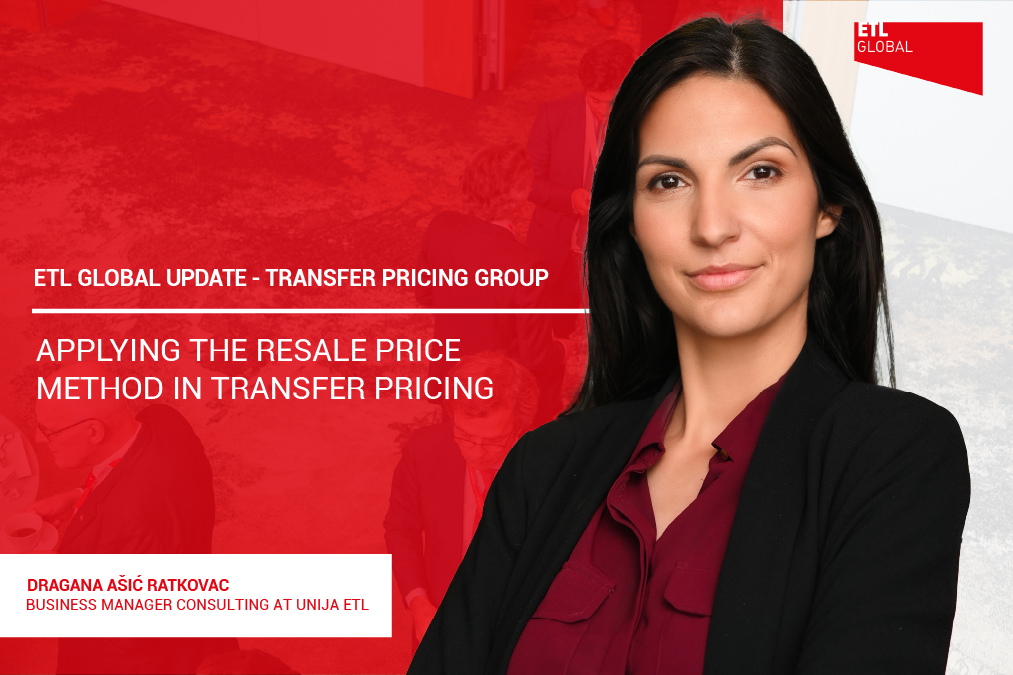The Resale Price Method (RPM) is typically employed when a company purchases goods or services from a related party and then resells them to unrelated third parties, with minimal added value or processing. RPM is particularly suitable in situations where the reseller performs limited functions such as distribution and marketing, as it is indicated by the OECD Guidelines, and where the resale price to unrelated parties is readily available.
This method is most effective when:
- Limited value-added activities: The reseller does not engage in significant transformation of the goods but instead simply adds a markup to the purchase price. This could include cases such as distribution or resale of finished goods without further processing.
- Availability of reliable resale prices: There is sufficient information regarding the prices at which comparable goods are sold to unrelated third parties, which allows for an accurate determination of the resale price margin.
- Low risk and minimal assets involved: The method is also appropriate when the reseller bears a relatively low level of risk and does not make significant investments in assets such as manufacturing facilities, intellectual property, or research and development.
RPM is generally preferred when the reselling company’s operations involve simple functions and when the transfer pricing analysis focuses on determining a fair resale margin based on market data.
In this method, the resale price at which a product is sold to an independent party is reduced by an appropriate gross margin (based on comparable uncontrolled transactions). The resulting amount reflects the arm’s length price that should have been paid by the reseller to the related supplier.
Arm’s length purchase price from the related party = Resale price to an unrelated party – Comparable gross margin
In the analysis, it is possible to use:
-
- Internal comparable margins – gross margin earned by the taxpayer or a group entity in a comparable transaction with an independent party.
- External comparable margins – gross margin earned by independent entities in a comparable transaction.
Internal comparables are generally preferred over external comparables. Where internal comparables cannot be identified, a market range should be determined – applying the rules for establishing an arm’s length range.
Conditions for the practical application of the RP Method:
-
- Differences between the compared transactions (if any) should not materially affect the resale margin under arm’s length conditions; and
- Reasonably accurate adjustments can be made to eliminate the material effects of any such differences.
- Fewer adjustments are generally required when applying the RP Method compared to the Comparable Uncontrolled Price (CUP) Method – minor product differences tend to have less impact on profit margins than on prices.
Key Considerations for Applying the Resale Price Method
The applicability of the Resale Price Method depends significantly on the comparability of functions performed, including the assets used and risks assumed, as well as the economic circumstances and business models of both the related and unrelated parties involved. Unlike the Comparable Uncontrolled Price (CUP) Method, the RPM allows for a lower degree of product comparability. This flexibility makes it particularly suitable for certain distribution models.
For example, a company engaged in the distribution of consumer goods may perform similar functions selling coffee makers as when selling blenders. In both cases, a similar level of compensation would generally be expected, as the functions performed by the distributor (such as marketing and logistics) are comparable. However, from the consumer’s perspective, coffee makers and blenders are not viewed as close substitutes. As such, it would not be reasonable to expect identical pricing for both products. Therefore, while the RPM can be used in these cases, pricing adjustments may be necessary based on the nature of the goods being sold.
When is the Resale Price Method Most Appropriate?
As mentioned above the RPM is most appropriate in scenarios where the reseller adds relatively little value to the goods being sold. In such cases, the resale price is largely determined by the market conditions, and the reseller is not involved in substantial value-added activities like manufacturing or processing.
However, if the goods are further processed or incorporated into more complex products before resale (e.g., components embedded into finished goods or semi-finished products), the reseller’s functions are considered more value-added. In these situations, the reliability of the RPM diminishes, and other transfer pricing methods may become more appropriate.
Time Factor and Market Fluctuations
The reliability of the RPM increases when the time between the acquisition of goods and their resale is relatively short. A shorter time frame minimizes the likelihood of significant changes in market conditions or cost structures. As time passes, other factors such as market changes, fluctuations in raw material costs, or exchange rate variations may significantly affect the analysis, necessitating more complex adjustments.
The Influence of Functions on Resale Margins
The amount of the resale margin is directly influenced by the level of functions performed by the reseller. The more functions a reseller performs, such as marketing, after-sales services, or customer support, the higher the expected gross margin. Conversely, if the reseller is involved in fewer activities, the gross margin would likely be lower. Therefore, the degree of value-added functions directly impacts the pricing of goods and the application of RPM.
Accounting Differences and Adjustments
One important consideration when applying the Resale Price Method is the potential for differences in accounting policies and standards between the controlled and uncontrolled transactions. For example, the classification of certain costs (such as distribution costs or marketing expenses) may differ. In such cases, it is essential to carry out adjustments to ensure that comparable costs are accounted for consistently. This ensures that the gross margin is calculated on a like-for-like basis, making the transfer pricing analysis more reliable.
Conclusion
The Resale Price Method is a valuable tool for transfer pricing, particularly when dealing with transactions where the reseller performs limited value-added functions. Its application is most effective when there is a relatively short time frame between acquisition and resale, and when the reseller’s role is mainly limited to distribution without significant changes to the product. However, as with all transfer pricing methods, the RPM requires careful consideration of the economic circumstances, functions performed, and adjustments for any accounting differences between related and unrelated parties.
By applying the RPM appropriately, companies can ensure their transfer pricing policies are in line with the arm’s length principle, ensuring compliance with both local and international tax regulations.
Example – Transfer Pricing Adjustment Calculation
Domestic Company A is a distributor of agricultural equipment for a foreign brand. Company A imported 1,500 units of agricultural equipment from its foreign parent company, Company B, at a purchase price of EUR 30,000 per unit.
During the year, Company A sold a total of 1,400 units on a wholesale basis at a sales price of EUR 35,000 per unit. All goods are exclusively imported from the related foreign company (Company B), and sales are exclusively made to unrelated third-party customers.
Since the CUP method could not be applied, and given that the goods are acquired from a related party and subsequently resold without any further processing or value-added activities (i.e., Company A does not enhance or modify the product), the Resale Price Method was selected for transfer pricing analysis.
| No. | Description | Amount |
| 1 | Quantity of goods purchased from the related party | 1,500 |
| 2 | Purchase price per unit | 30,000 |
| 3 = 1 × 2 | Total purchase value of goods | 45,000,000 |
| 4 | Sales price per unit | 35,000 |
| 5 | Quantity of goods sold to unrelated parties | 1,400 |
| 6 = 2 × 5
|
Purchase value of goods sold at transfer prices
|
42,000,000
|
| No. | Description | Amount |
| 1 | Quantity of goods purchased from the related party | 1,500 |
| 2 | Purchase price per unit | 30,000 |
By applying a statistical method whereby, the gross margins of comparable independent companies are divided into quartiles, the following arm’s length range of gross margins (from the first to the third quartile) has been determined:
| Minimum | 13,00% |
| First quartile | 16,00% |
| Median | 18,00% |
| Third quartile | 19,50% |
| Maximum | 22,00% |
Considering that the gross margin of Company A, which amounts to 14.29% in the controlled transaction, falls below the arm’s length range of gross margins (16% – 19.50%), it is necessary to calculate a transfer pricing adjustment on the expense side of Company A to bring it in line with the median value (18%).
| No. | Description | Amount |
| 1 | Revenue from goods sold to unrelated parties | 49,000,000 |
| 2 | Arm’s length gross margin – median | 18.00% |
| 3 = 1 × 2 | Arm’s length gross profit | 8,820,000 |
| 4 | Purchase value of goods sold at transfer prices | 42,000,000 |
| 5 = 1 – 3 | Purchase value of goods sold in accordance with the arm’s length principle | 40,180,000 |
| 6 = 4 – 5 | Transfer pricing adjustment on the expense side of the reseller | 1,820,000 |





